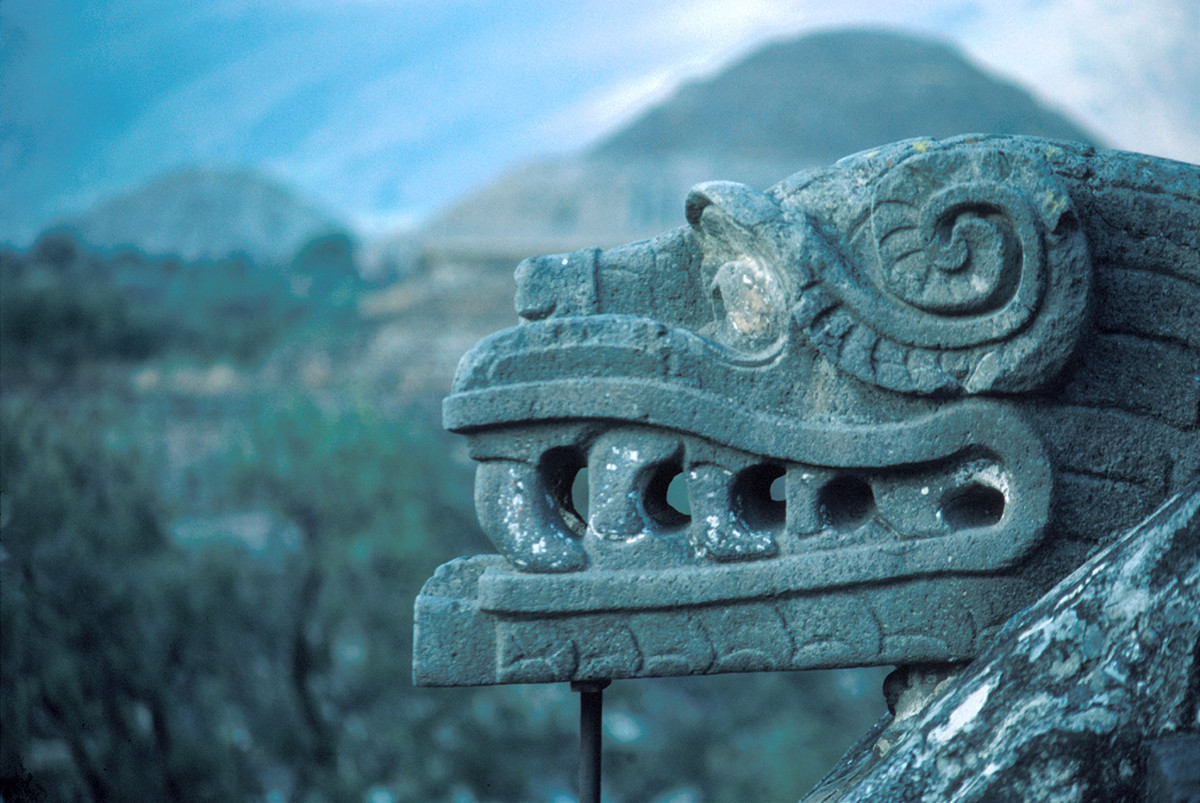 When you think of Mexican mythology, you might not think of flying dragons, but nevertheless in Mexico’s pre-Hispanic recollections there exists a mythical god who was symbolized as a flying dragon, or also called, a feathered serpent, or the Quetzal-like flying snake. In the native Nahuatl Aztec tongue, the name was Quetzalcoatl, also known in the Mayan mythology and history as Kukulcan, and other names attributed to him are Gucumatz, and Votan. He may have been called a feathered serpent because he was envisioned as a flying serpent, which brings to mind the flying dragons of mystic Chinese paintings. This symbol of the flying serpent represented one of the greatest gods of ancient Mexico. In the eyes of the Aztecs their religion is their philosophy, their science and their life values.
When you think of Mexican mythology, you might not think of flying dragons, but nevertheless in Mexico’s pre-Hispanic recollections there exists a mythical god who was symbolized as a flying dragon, or also called, a feathered serpent, or the Quetzal-like flying snake. In the native Nahuatl Aztec tongue, the name was Quetzalcoatl, also known in the Mayan mythology and history as Kukulcan, and other names attributed to him are Gucumatz, and Votan. He may have been called a feathered serpent because he was envisioned as a flying serpent, which brings to mind the flying dragons of mystic Chinese paintings. This symbol of the flying serpent represented one of the greatest gods of ancient Mexico. In the eyes of the Aztecs their religion is their philosophy, their science and their life values.
Aztec mythology explains that Quetzalcoatl, god of the morning star, was born with his twin Xolotl, god of the evening star, or Venus, to Coatlicue—goddess of fire, fertility, life and death—in a virgin birth, and that she was impregnated by a ball of feathers that she swept into the Temple. To the Toltecs, Quetzalcoatl was considered the god of arts and all knowledge but thought to be the god of dying and resurrection, as well as the patron of the priests to the Aztecs. He was also the creator of books, knowledge and the calendar. It was believed by the Aztecs that he brought corn to mankind, much like Prometheus brought fire to humankind. The doctrine that Quetzalcoatl brought to the Aztecs was the belief in only one god and he did not approve of human sacrifice.
Another Quetzalcoatl was a man, who has a historical presence in Mexico’s past. Quetzalcoatl the man, was born in a beautiful town, Amatlan, nestled on a ridge of jutting mountains called the Tepozteco in the Valley of Cuauhnahuac, near the City of Cuernavaca, Morelos. Legend says that these mountains are inhabited by highly illuminated souls that will one day give the world advanced knowledge. His birth is also attributed to another renowned religious center in the State of Morelos called Xochicalco. His father was a strong leader and conqueror of the Toltecs called Mixcoatl, which means “Cloud Serpent,” and there is a huge statue in his honor in the commercial center of Cholula in the State of Puebla, as recognition to his feats as a warrior. Quetzalcoatl’s mother was Chimalman, a princess of the Toltec aristocracy, and it is said that he emerged from her womb in full military attire when she gave birth to him. His mother died four days after his birth, and he was named Topiltzin Quetzalcoatl. Together with his father Mixcoatl they conquered all of the Valley of Mexico. These military campaigns took place around the year 950 A.D. The conquests continued to expand taking in all the territory from the Valley of Mexico to the Gulf Coast and into the Yucatan peninsula. He created an army of Jaguar and Eagle warriors that dominated all of the States of Hidalgo, Puebla, along the Gulf Coast into the State of Veracruz, and the Yucatan Peninsula. As he led his troops from victory to victory he conquered the Mayas and also befriended priests of the region, who would later record his triumphs in the Popol Vuh. He is said to have died in what the Mayas refer to as the land of the Red and the Black, in the Yucatan peninsula.
The most Mexican of symbols would be the eagle in the center of the Mexican flag. It represents a royal eagle standing on a cactus devouring a serpent. The significance of these symbols is directly related to the Aztec mythology, the eagle representing Huitzilopochtli who was the Sun God and the rival of Quetzalcoatl. Hutzilopochtli would turn into an eagle at night and would hunt down stars in an attempt to fight against the night. In the most classic symbol we see the eagle devouring the snake that represents Quetzalcoatl. This also takes us back to the Aztec prophesy that said: when the Aztecs where wandering the lands of the North and they found an eagle that was devouring a snake they had come upon the place that would be the site of their new city. When they came to the Valley of Mexico they saw the eagle of this prophesy, and it determined their settlement in what today is Mexico City.



